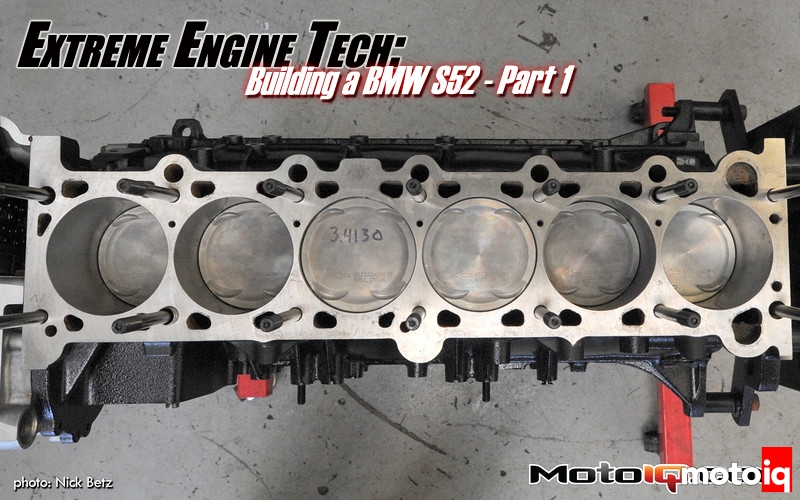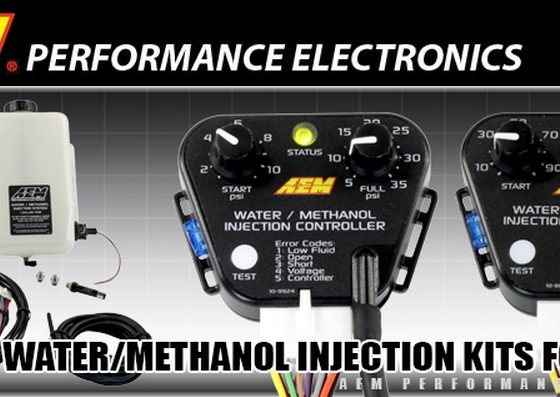,

This is a standard S52 crank with a stroke of 89.6mm, much larger than the original 75mm stroke from our old crank. We had Pure Performance do some work on it which included balancing, straightening and micro-polishing.
 The M52/S52 modularity continues with the rods. Both engines house a 135mm rod, so we could have reused the old rods from our used S52, but we decided to upgrade to Pro-H beams from Carrillo. The benefit of an H-Beam is higher resistance to lateral torsional buckling which is the primary mode of failure for most I-beam structures under compression. The H Beam is for extreme use and is stronger for it's weight because its resistance to buckling loads is greatest in the direction which the rod is stressed the most. The H Beam is a more expensive design because the forging is now a multi step process.
The M52/S52 modularity continues with the rods. Both engines house a 135mm rod, so we could have reused the old rods from our used S52, but we decided to upgrade to Pro-H beams from Carrillo. The benefit of an H-Beam is higher resistance to lateral torsional buckling which is the primary mode of failure for most I-beam structures under compression. The H Beam is for extreme use and is stronger for it's weight because its resistance to buckling loads is greatest in the direction which the rod is stressed the most. The H Beam is a more expensive design because the forging is now a multi step process. 
The Carrillo rod starts as a near net shape blank of forged proprietary steel alloy consisting of chrome, nickel, moly and vanadium alloying elements which meets all VAR (vacuum arc re-melt ASTM standards). Vacuum remelting reduces impurities and pockets in the base metal to reduce internal defects which acts as stress risers and points of potential failure. Carrillo rods are heat treated using a maraging process, resulting in an ultimate tensile strength of 195,000 psi with a yield point of 182,000 psi. Maraging means that the alloy used is a maraging steel alloy. These alloys are known for strength without the brittleness associated with many strong and hard steel alloys. A Maraging alloy is precipitation heat treated to convert most of the austenite (a less strong form of steel) to martensite (a stronger form that the heat treating distributes through the steel's crystal structure). All Carrillo connecting rods are CNC machined from an oversized blank forging resulting in the proper grainflow and are surface machined to ensure the removal of any potential inclusions or surface conversions such as scale generated by the forging process. These inclusions can cause stress risers that reduces cyclic fatigue strength. A final multistage shotpeen operation completes the rod. Shotpeening greatly improves fatigue strength by forming a tough fine grained surface skin on the part. Carrillo Rods are built here in the USA. They are fully machined, Magnaflux inspected, and balanced as a set to +/- 1 gram before being shipped to the customer.
 With any rod, the bolts are the most highly stressed and critical part. Carrillo Pro-H rods come with CARR fasteners. The CARR fasteners are made from Multiphase TM material giving them a higher Ultimate Tensile Strength (UTS). Carrillo rod bolts are a proprietary design with asymmetrical threads that have more engagement on the thrust side for better strength and more accurate torque readings. The base bolts are made of super strong H11 tool steel. H11 is a steel alloy with high amounts of chromium that exhibits a high degree of tensile strength and toughness. The H11 bolts have an impressive ultimate tensile strength of 220,000 psi.
With any rod, the bolts are the most highly stressed and critical part. Carrillo Pro-H rods come with CARR fasteners. The CARR fasteners are made from Multiphase TM material giving them a higher Ultimate Tensile Strength (UTS). Carrillo rod bolts are a proprietary design with asymmetrical threads that have more engagement on the thrust side for better strength and more accurate torque readings. The base bolts are made of super strong H11 tool steel. H11 is a steel alloy with high amounts of chromium that exhibits a high degree of tensile strength and toughness. The H11 bolts have an impressive ultimate tensile strength of 220,000 psi. As with the rods our S52 pistons were in fine shape. Yes, we could have reused them, and if you’re looking to do this build on a budget, then it’s a great option. Since we wanted to get a little more power from our new engine, however, we went with a set of Mahle Power Pak Pistons.
As with the rods our S52 pistons were in fine shape. Yes, we could have reused them, and if you’re looking to do this build on a budget, then it’s a great option. Since we wanted to get a little more power from our new engine, however, we went with a set of Mahle Power Pak Pistons. 
And that’s where the secret to our build was found. In search of more power we opted for our Mahle pistons to come in at 11.3:1 compression and an 86.6mm bore. Going .20 over meant the block had to be bored to match. A nice feature of Mahle Power Pak Pistons is the Phosphate coating which is a dry-lubricant coating that gives it the grey appearance. This dry lubricant coating helps with initial start up and breaking in of engines as it protects against galling and microwelding when the engine reaches its operating oil temps.




2 comments
Not sure when this was posted but thanks! I’ve had a lot of BMWs in the past but nothing later than an e30 and am now looking into a ’96 e36 328is. I’ve been searching for REAL information about a sensible but effective build to reach the M series performance levels and this is the first REAL build I’ve found that speaks my language (brought up on hot rods and muscle cars) My main question is how can you increase the stroke without shortening either the rods or piston pin height?? Or do the M3 pistons have a different pin placement than the m50/52? (I was trying to avoid using all the m50 etc, frankly you need a damn score card to keep track of it all.
One of the first questions I had after reviewing engine specs was if the M car crank will fit the IS block and cool – yes it will! Another was how much the cast iron blocks can be overbored another point! So now I can toss out all that fan boy (never actually built a motor but know it all) “info” and get back to a proper build, bore, stroke, pistons, cams and go. One question if you are still reading… actually I am going to add this up top. RE pistons 323 328 vs M3 seems to me you can’t increase the stroke without shortening something either the rod length or piston pin height.?
Thank y’all for this write up. Restoring my M3 (minus stuff that weighs too much) and my dad rebuilt my motor for Christmas from this post. Big time.